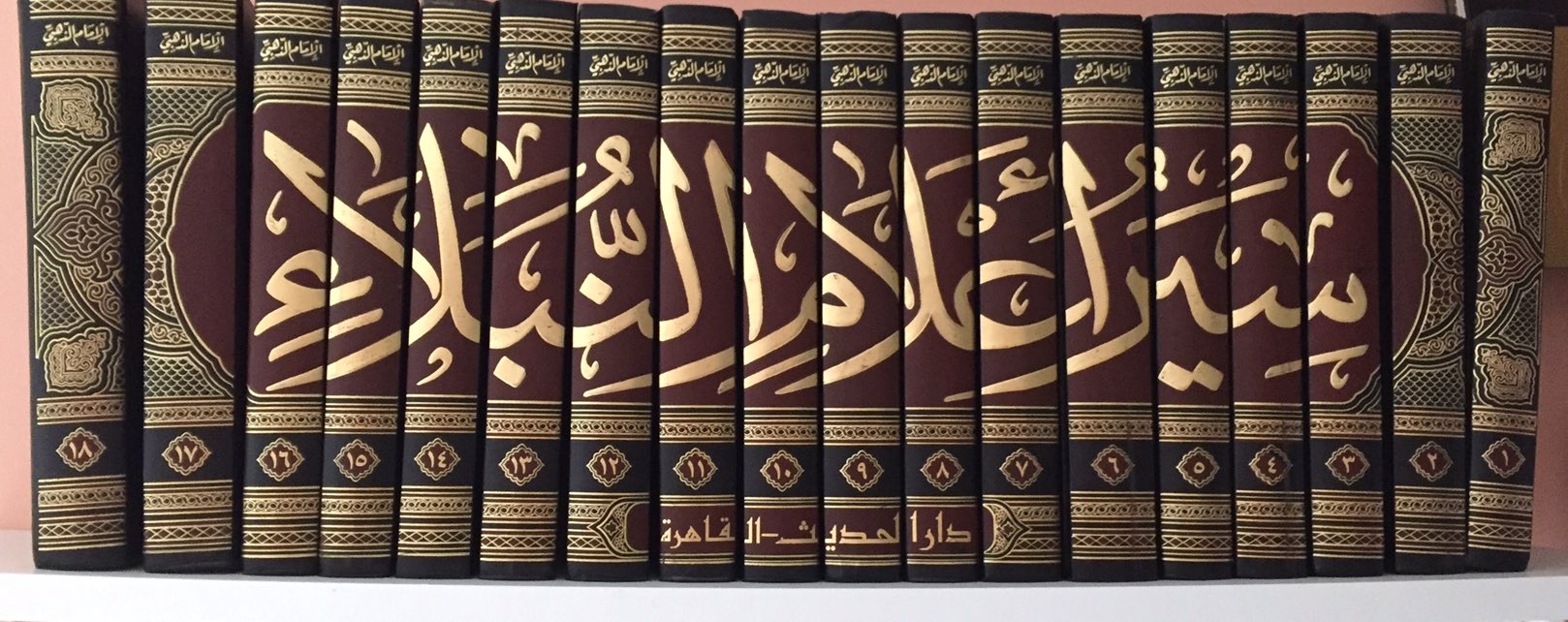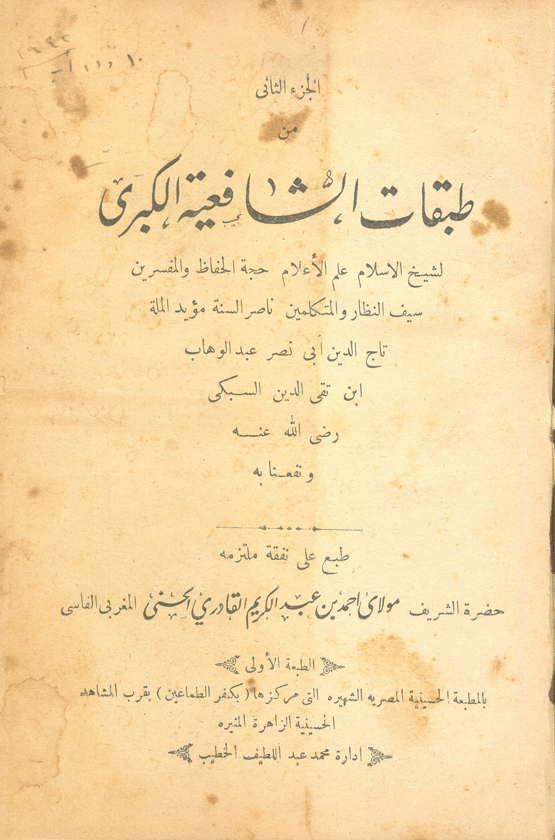|
Siyar A'lam Al-Nubala'
''Siyar A'lam al-Nubala ( ar, سير أعلام النبلاء) is a book written by al-Dhahabi containing the biographies of different Sahaba, ulema, rulers, ministers, and poets who lived between the time of Muhammad and that of al-Dhahabi, in addition to the seerah of Muhammad himself. Al-Dhahabi divided the book into chapters according to the generations in which the different personalities, most of whom were Muhaddiths, lived. See also * Tabaqat al-Shafi'iyya al-Kubra References 13th-century Arabic-language books 13th-century encyclopedias 14th-century Arabic-language books 14th-century encyclopedias Biographical dictionaries {{bio-dict-stub ... [...More Info...] [...Related Items...] OR: [Wikipedia] [Google] [Baidu] |
Al-Dhahabi
Shams ad-Dīn adh-Dhahabī (), also known as Shams ad-Dīn Abū ʿAbdillāh Muḥammad ibn Aḥmad ibn ʿUthmān ibn Qāymāẓ ibn ʿAbdillāh at-Turkumānī al-Fāriqī ad-Dimashqī (5 October 1274 – 3 February 1348) was an Islamic historian and Hadith expert. Life Of Arab descent, Adh-Dhahabi was born in Damascus. His name, ibn adh-Dhahabi (son of the goldsmith), reveals his father's profession. He began his study of hadith at age eighteen, travelling from Damascus to Baalbek, Homs, Hama, Aleppo, Nabulus, Cairo, Alexandria, Jerusalem, Hijaz, and elsewhere, before returning to Damascus to teach and write. He authored many works and was widely renown as a perspicuous critic and expert examiner of the hadith. He wrote an encyclopaedic biographical history and was the foremost authority on the canonical readings of the Qur'an. Some of his teachers were women. At Baalbek, Zaynab bint ʿUmar b. al-Kindī was among his most influential teachers. Adh-Dhahabi lost his sight two ye ... [...More Info...] [...Related Items...] OR: [Wikipedia] [Google] [Baidu] |
Sahaba
The Companions of the Prophet ( ar, اَلصَّحَابَةُ; ''aṣ-ṣaḥāba'' meaning "the companions", from the verb meaning "accompany", "keep company with", "associate with") were the disciples and followers of Muhammad who saw or met him during his lifetime, while being a Muslim and were physically in his presence. "Al-ṣaḥāba" is definite plural; the indefinite singular is masculine ('), feminine ('). Later Islamic scholars accepted their testimony of the words and deeds of Muhammad, the occasions on which the Quran was revealed and other various important matters of Islamic history and practice. The testimony of the companions, as it was passed down through trusted chains of narrators (''isnad''s), was the basis of the developing Islamic tradition. From the traditions (''hadith'') of the life of Muhammad and his companions are drawn the Muslim way of life ('' sunnah''), the code of conduct (''sharia'') it requires, and the jurisprudence (''fiqh'') by which ... [...More Info...] [...Related Items...] OR: [Wikipedia] [Google] [Baidu] |
Ulema
In Islam, the ''ulama'' (; ar, علماء ', singular ', "scholar", literally "the learned ones", also spelled ''ulema''; feminine: ''alimah'' ingularand ''aalimath'' lural are the guardians, transmitters, and interpreters of religious knowledge in Islam, including Islamic doctrine and law. By longstanding tradition, ulama are educated in religious institutions ''(madrasas)''. The Quran and sunnah (authentic hadith) are the scriptural sources of traditional Islamic law. Traditional way of education Students do not associate themselves with a specific educational institution, but rather seek to join renowned teachers. By tradition, a scholar who has completed his studies is approved by his teacher. At the teacher's individual discretion, the student is given the permission for teaching and for the issuing of legal opinions ''( fatwa)''. The official approval is known as the '' ijazat at-tadris wa 'l-ifta'' ("license to teach and issue legal opinions"). Through time ... [...More Info...] [...Related Items...] OR: [Wikipedia] [Google] [Baidu] |
Muhammad
Muhammad ( ar, مُحَمَّد; 570 – 8 June 632 Common Era, CE) was an Arab religious, social, and political leader and the founder of Islam. According to Muhammad in Islam, Islamic doctrine, he was a prophet Divine inspiration, divinely inspired to preach and confirm the tawhid, monotheistic teachings of Adam in Islam, Adam, Abraham in Islam, Abraham, Moses in Islam, Moses, Jesus in Islam, Jesus, and other Prophets and messengers in Islam, prophets. He is believed to be the Seal of the Prophets within Islam. Muhammad united Arabian Peninsula, Arabia into a single Muslim polity, with the Quran as well as his teachings and practices forming the basis of Islamic religious belief. Muhammad was born approximately 570CE in Mecca. He was the son of Abdullah ibn Abd al-Muttalib and Amina bint Wahb. His father Abdullah was the son of Quraysh tribal leader Abd al-Muttalib ibn Hashim, and he died a few months before Muhammad's birth. His mother Amina died when he was six, lea ... [...More Info...] [...Related Items...] OR: [Wikipedia] [Google] [Baidu] |
Seerah
Al-Sīra al-Nabawiyya (), commonly shortened to Sīrah and translated as prophetic biography, are the traditional Muslim biographies of Muhammad from which, in addition to the Quran and Hadiths, most historical information about his life and the early period of Islam is derived. Etymology In the Arabic language the word ''sīra'' or ''sīrat'' ( ar, سيرة) comes from the verb ''sāra,'' which means to travel or to be on a journey. A person's ''sīra'' is that person's journey through life, or biography, encompassing their birth, events in their life, manners and characteristics, and their death. In modern usage it may also refer to a person's resume. It is sometimes written as "seera", "sirah" or "sirat", all meaning "life" or "journey". In Islamic literature, the plural form, ''siyar'', could also refer to the rules of war and dealing with non-Muslims. The phrase ''sīrat rasūl allāh'', or ''as-sīra al-nabawiyya'', refers to the study of the life of Muhammad. The te ... [...More Info...] [...Related Items...] OR: [Wikipedia] [Google] [Baidu] |
Muhaddiths
Hadith studies ( ar, علم الحديث ''ʻilm al-ḥadīth'' "science of hadith", also science of hadith, or science of hadith criticism or hadith criticism) consists of several religious scholarly disciplines used by Muslim scholars in the study and evaluation of the Islamic hadith—i.e. the record of the words, actions, and the silent approval of the Islamic prophet, Muhammad. Determining authenticity of hadith is enormously important in Islam because along with the Quran, the '' Sunnah'' of the Islamic prophet—his words, actions, and the silent approval—are considered the explanation of the divine revelation ('' wahy''), and the record of them (i.e. hadith) provides the basis of Islamic law ( Sharia). In addition, while the number of verses pertaining to law in the Quran is relatively few, hadith give direction on everything from details of religious obligations (such as '' Ghusl'' or ''Wudu'', ablutions An-Nawawi, ''Riyadh As-Salihin'', 1975: p.203 for '' salat' ... [...More Info...] [...Related Items...] OR: [Wikipedia] [Google] [Baidu] |
Tabaqat Al-Shafi'iyya Al-Kubra
Tabaqat al-Shāfi'iyya al-Kubra ( ar, طبقات الشافعية الكبرى, lit=The Major Classes/Generations of the Shafi'is) is a voluminous encyclopedic biographical dictionary written by the Shafi'i-Ash'ari scholar Taj al-Din al-Subki (d. 771/1370), in which he presents biographies of scholars of the Shafi'i legal school in Sunni Islam, from the time of Muhammad ibn Idris al-Shafi'i (d. 204/820) all the way to his own contemporary time. The work also chronicles the history of the Ash'ari school of thought, since its beginning with Abu al-Hasan al-Ash'ari (d. 324/936) all the way to Taj al-Din al-Subki's own era; because most of the Ash'ari scholars are following the Shafi'i school of Islamic jurisprudence. Content The work is divided into seven classes ( tabaqat), as follows: # Those who were students (disciples) of Imam al-Shafi'i (d. 204/820), the founder of the Shafi'i school. # Those who died between 200 AH and 300 AH. # Those who died between 300 AH and 400 ... [...More Info...] [...Related Items...] OR: [Wikipedia] [Google] [Baidu] |
13th-century Arabic-language Books
The 13th century was the century which lasted from January 1, 1201 ( MCCI) through December 31, 1300 ( MCCC) in accordance with the Julian calendar. The Mongol Empire was founded by Genghis Khan, which stretched from Eastern Asia to Eastern Europe. The conquests of Hulagu Khan and other Mongol invasions changed the course of the Muslim world, most notably the Siege of Baghdad (1258), the destruction of the House of Wisdom and the weakening of the Mamluks and Rums which, according to historians, caused the decline of the Islamic Golden Age. Other Muslim powers such as the Mali Empire and Delhi Sultanate conquered large parts of West Africa and the Indian subcontinent, while Buddhism witnessed a decline through the conquest led by Bakhtiyar Khilji. The Southern Song dynasty would begin the century as a prosperous kingdom but would eventually be invaded and annexed into the Yuan dynasty of the Mongols. The Kamakura Shogunate of Japan would be invaded by the Mongols. Goryeo resiste ... [...More Info...] [...Related Items...] OR: [Wikipedia] [Google] [Baidu] |
13th-century Encyclopedias
The 13th century was the century which lasted from January 1, 1201 ( MCCI) through December 31, 1300 ( MCCC) in accordance with the Julian calendar. The Mongol Empire was founded by Genghis Khan, which stretched from Eastern Asia to Eastern Europe. The conquests of Hulagu Khan and other Mongol invasions changed the course of the Muslim world, most notably the Siege of Baghdad (1258), the destruction of the House of Wisdom and the weakening of the Mamluks and Rums which, according to historians, caused the decline of the Islamic Golden Age. Other Muslim powers such as the Mali Empire and Delhi Sultanate conquered large parts of West Africa and the Indian subcontinent, while Buddhism witnessed a decline through the conquest led by Bakhtiyar Khilji. The Southern Song dynasty would begin the century as a prosperous kingdom but would eventually be invaded and annexed into the Yuan dynasty of the Mongols. The Kamakura Shogunate of Japan would be invaded by the Mongols. Goryeo ... [...More Info...] [...Related Items...] OR: [Wikipedia] [Google] [Baidu] |
14th-century Arabic-language Books
As a means of recording the passage of time, the 14th century was a century lasting from 1 January 1301 ( MCCCI), to 31 December 1400 (MCD). It is estimated that the century witnessed the death of more than 45 million lives from political and natural disasters in both Europe and the Mongol Empire. West Africa experienced economic growth and prosperity. In Europe, the Black Death claimed 25 million lives wiping out one third of the European population while the Kingdom of England and the Kingdom of France fought in the protracted Hundred Years' War after the death of Charles IV, King of France led to a claim to the French throne by Edward III, King of England. This period is considered the height of chivalry and marks the beginning of strong separate identities for both England and France as well as the foundation of the Italian Renaissance and Ottoman Empire. In Asia, Tamerlane (Timur), established the Timurid Empire, history's third largest empire to have been ever establi ... [...More Info...] [...Related Items...] OR: [Wikipedia] [Google] [Baidu] |
14th-century Encyclopedias
As a means of recording the passage of time, the 14th century was a century lasting from 1 January 1301 ( MCCCI), to 31 December 1400 (MCD). It is estimated that the century witnessed the death of more than 45 million lives from political and natural disasters in both Europe and the Mongol Empire. West Africa experienced economic growth and prosperity. In Europe, the Black Death claimed 25 million lives wiping out one third of the European population while the Kingdom of England and the Kingdom of France fought in the protracted Hundred Years' War after the death of Charles IV, King of France led to a claim to the French throne by Edward III, King of England. This period is considered the height of chivalry and marks the beginning of strong separate identities for both England and France as well as the foundation of the Italian Renaissance and Ottoman Empire. In Asia, Tamerlane (Timur), established the Timurid Empire, history's third largest empire to have been ever establi ... [...More Info...] [...Related Items...] OR: [Wikipedia] [Google] [Baidu] |






